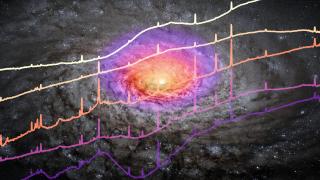Bibcode
García-Lorenzo, Begoña; Monreal-Ibero, Ana; Mediavilla, Evencio; Pereira-Santaella, Miguel; Thatte, Niranjan
Referencia bibliográfica
Frontiers in Astronomy and Space Sciences
Fecha de publicación:
12
2019
Número de citas
4
Número de citas referidas
4
Descripción
We present preliminary results on the potential of HARMONI, the first light integral field spectrograph for the ELT, to explore the evolution of central super massive black holes (SMBH) - host galaxy relation in the range from z̃0.7 to z̃2.5. We simulated HARMONI observations of QSO+host galaxy at different redshifts, assuming different morphologies for the host galaxy. As input, we combined MUSE observations of nearby galaxies and a theoretical QSO spectrum. These were dimmed and redshifted to the desired cosmic epoch. We scaled the total host galaxy luminosity to three different values, sampling three orders of magnitude. Likewise, we assumed two different luminosities for the central QSO. Simulations were performed for the 30×60 mas2 HARMONI spatial scale and LTAO working at 0.67 arcsec seeing. The selected wavelength range (i.e. 4700-5300 A ̊ at rest-frame) was sampled at the lowest HARMONI spectral resolving power (i.e. R̃3200). This configuration included all the ingredients to estimate the host galaxy parameters and the SMBH mass, as well as for assessing the morphological type of the host galaxy.
Proyectos relacionados

Actividad Nuclear en Galaxias: una Perspectiva 3D del Núcleo y su Entorno
Nuestro proyecto puede dividirse en dos líneas principales de investigación. En primer lugar, el estudio de los vientos producidos por cuásares luminosos oscurecidos y del impacto que estos tienen en sus galaxias anfitrionas (retroalimentación del AGN). Para ello hemos obtenido observaciones en el óptico e infrarrojo cercano con el Gran Telescopio
Cristina
Ramos Almeida